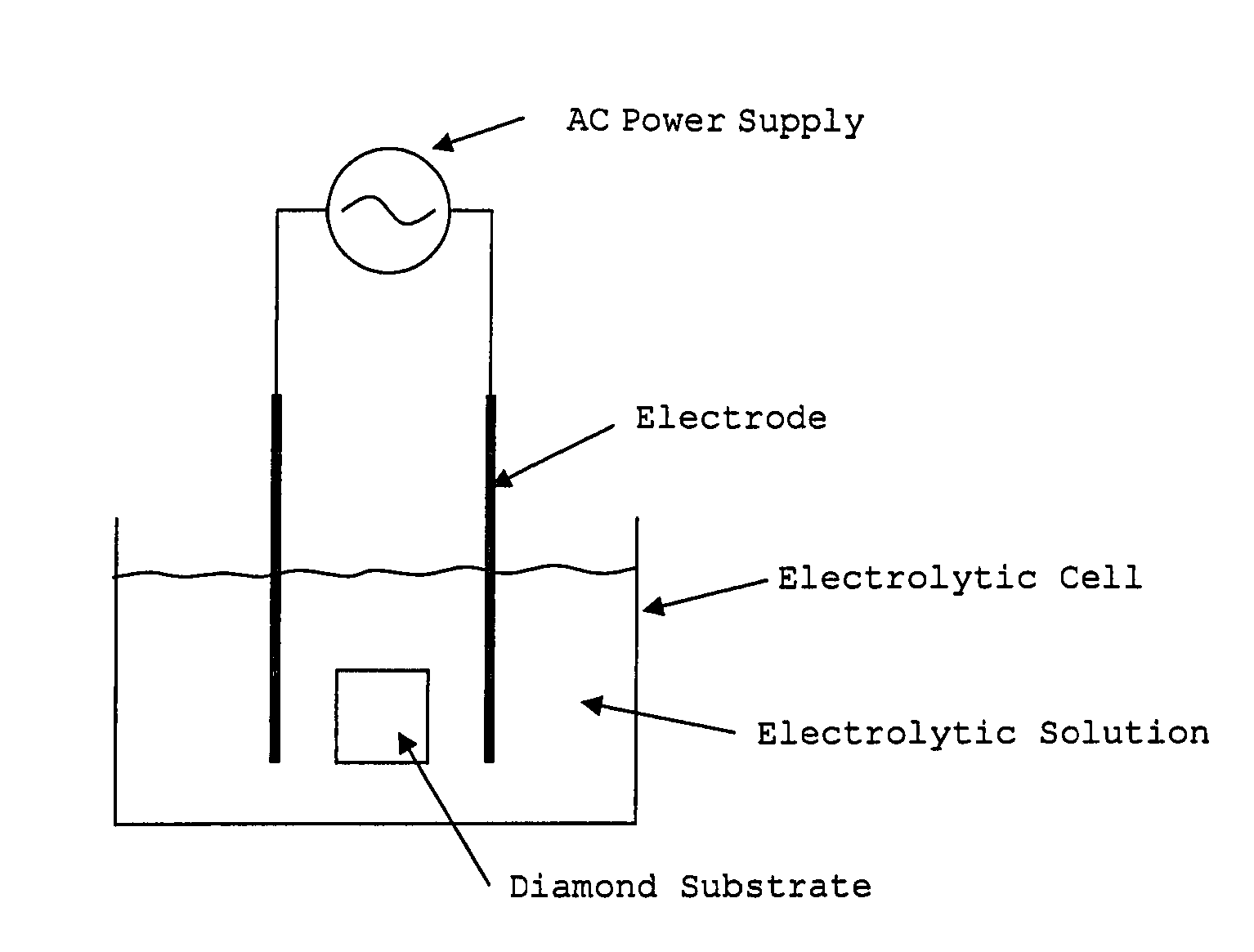Method for separating surface layer or growth layer of diamond
a growth layer and surface layer technology, applied in the direction of polycrystalline material growth, manufacturing tools, after-treatment details, etc., can solve the problems of reducing yield, synthesis requiring an extremely long time, and high cost of large single-crystal diamonds, so as to achieve easy separation, short separation time, and high separation efficiency
- Summary
- Abstract
- Description
- Claims
- Application Information
AI Technical Summary
Benefits of technology
Problems solved by technology
Method used
Image
Examples
example 1
[0061]A high-temperature high-pressure synthetic Ib diamond (100) substrate with a size of 9.3×9.5×1.05 mm3 was used as a substrate, and carbon ions were implanted into the substrate at an implantation energy of 3 MeV and a dose of 2×1016 ions / cm2, using a 1.5 MV tandem accelerator. The projectile range of the implanted ions was calculated using a Monte Carlo simulation code, and the result was about 1.6 μm. As a result of this irradiation, the color of the diamond substrate changed from a pale yellow to black; this confirmed that a non-diamond layer had been formed.
[0062]The ion-implanted substrate was placed in a commercially available microwave plasma CVD apparatus, after which hydrogen gas was introduced into the CVD chamber, and microwave power was applied to generate plasma. The microwave power was set to about 3 kW, with the hydrogen gas flow rate set at 500 sccm and the pressure at 24 kPa, so that the substrate temperature was 1,130° C., and these conditions were maintained ...
example 2
[0067]A diamond was produced by growing a vapor-phase synthetic diamond to a thickness of 8.7 mm on a high-temperature high-pressure synthetic Ib diamond (100) substrate with a size of about 6×6 mm according to a microwave plasma CVD method. The resulting bulk single crystal was sliced along the (100) plane perpendicular to the growth face, and the surface of the slice was polished to prepare a single-crystal diamond substrate in the form of a 6×8.5×1.02 mm3 trapezoid. Using this substrate, ion implantation and epitaxial growth of a diamond by a microwave plasma CVD method were performed according to the same method as Example 1.
[0068]After the growth, the diamond deposited around the ion-implanted layer on the substrate-side surface was removed by laser cutting, and etching was performed in the same manner as Example 1. An AC voltage with an effective value of 5.6 kV and a frequency of 60 Hz was applied across the electrodes, using pure water as an electrolytic solution, with the e...
example 3
[0072]The surface (the separated face) of the high-temperature high-pressure synthetic Ib diamond (100) substrate, i.e., the surface from which the diamond grown layer was separated in Example 1, was subjected to ion implantation and diamond growth by a microwave CVD method according to the same method as Example 1.
[0073]After the growth of a single-crystal diamond, the diamond deposited around the ion-implanted layer on the substrate-side surface was removed by laser cutting, and etching was performed by applying an AC voltage in pure water as in Example 1, thereby separating the diamond grown layer from the substrate. As a result, a CVD diamond plate with a thickness of about 400 μm was separated.
[0074]As a result of repeating this method three times, CVD diamond plates of similar thicknesses were successfully separated.
PUM
| Property | Measurement | Unit |
|---|---|---|
| resistivity | aaaaa | aaaaa |
| size | aaaaa | aaaaa |
| size | aaaaa | aaaaa |
Abstract
Description
Claims
Application Information
 Login to View More
Login to View More - R&D
- Intellectual Property
- Life Sciences
- Materials
- Tech Scout
- Unparalleled Data Quality
- Higher Quality Content
- 60% Fewer Hallucinations
Browse by: Latest US Patents, China's latest patents, Technical Efficacy Thesaurus, Application Domain, Technology Topic, Popular Technical Reports.
© 2025 PatSnap. All rights reserved.Legal|Privacy policy|Modern Slavery Act Transparency Statement|Sitemap|About US| Contact US: help@patsnap.com


